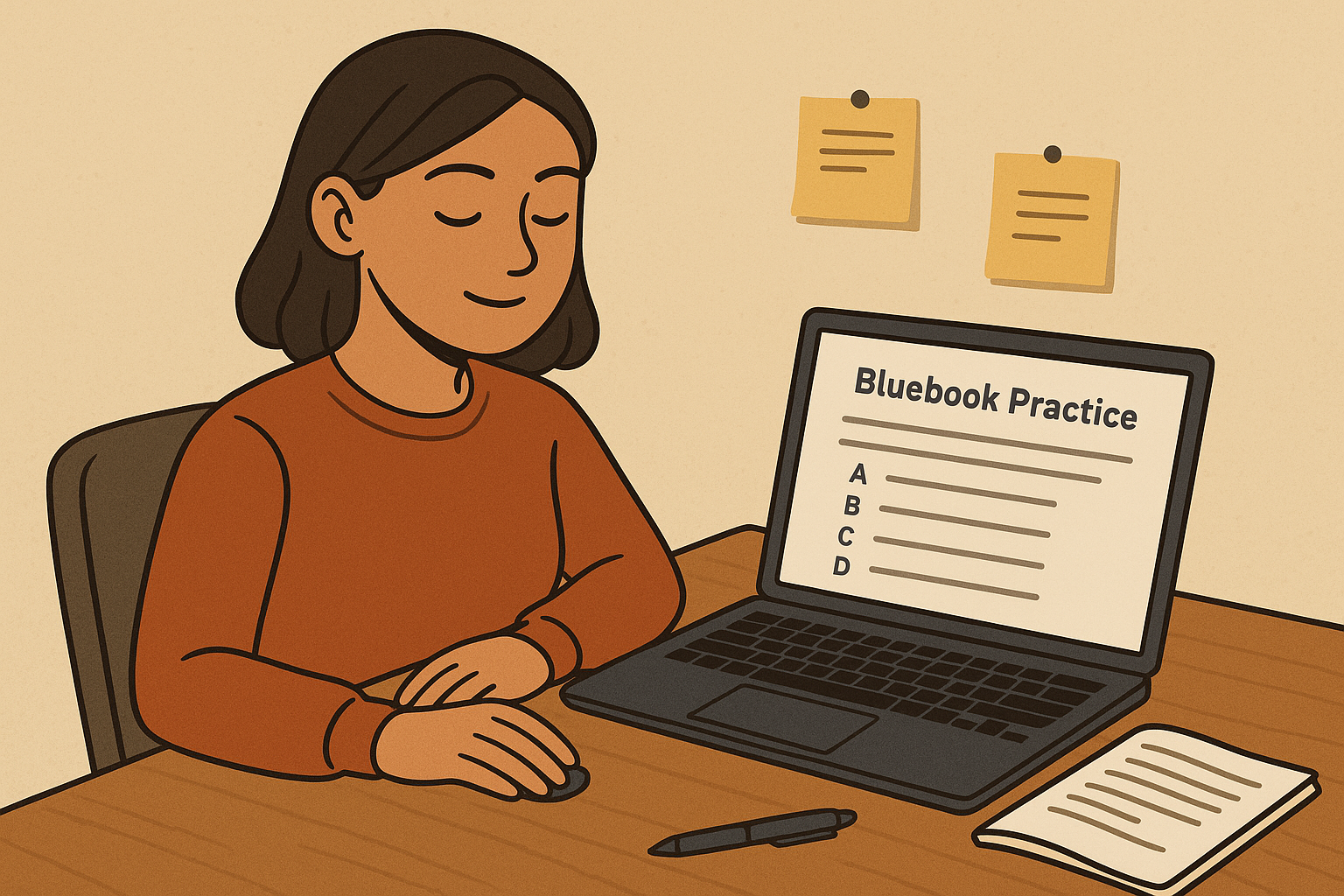Why This Matters: Confidence Isn’t Luck—It’s Practice
Picture this: you sit down at your Digital SAT testing device, breathe in, and think, “I’ve seen this before. I know what to do.” That quiet steadiness? That’s not magic. It’s the reward of focused practice. For most students, the difference between anxiety and calm, between a so-so score and a personal best, comes down to how they practiced—what they practiced—and how deliberately they did it.
The Big Idea: Quality Beats Quantity
Studying longer hours feels productive, but the SAT doesn’t reward busywork. It rewards targeted, thoughtful practice. Focused practice means isolating the skills and question types that matter, deliberately practicing them until your brain develops quick, reliable strategies, and then reinforcing them with timed, realistic practice.
What focused practice looks like
- Identify a narrow weakness (for example: Command of Evidence questions in Reading, or linear equations in Math).
- Choose a small set of high-quality practice items that target that weakness.
- Practice them slowly at first, analyze mistakes, learn patterns, and then speed up with timed drills.
- Repeat with variations until the pattern recognition and strategy feel automatic.
How Focused Practice Builds Confidence (Step by Step)
Confidence on test day isn’t an emotion you can force; it’s a skill you cultivate. Here’s how focused practice builds it, in practical terms.
1. Reduces the unknown
The Digital SAT has a structure and types of questions that repeat. Focused practice familiarizes you with those patterns—so you spend less time figuring out what a question is asking and more time solving it. The less “newness” you face, the less your adrenaline spikes.
2. Turns mistakes into data
Every wrong answer becomes information. Instead of feeling demoralized, you learn to ask: Was that a content gap, a careless error, or a timing issue? Focused practice helps you categorize errors quickly and fix them with specific drills.
3. Builds reliable habits
When you practice the same type of problem repeatedly with reflection, you build mental shortcuts: how to annotate a reading passage, which algebra steps to do first, or when to plug in numbers. Those habits are calming because they’re reliable under pressure.
4. Creates momentum
Small wins compound. Solve three reading questions correctly that you used to miss? That’s a confidence boost. Fast-forward six weeks of focused wins, and test day feels like the same achievement routine you’ve practiced, not a risky performance.
Practical Focused-Practice Plan: 8 Weeks to Steady Confidence
Below is a practical framework you can adapt to your schedule. It breaks prep into focused blocks so you’re always improving the most important things.
| Week | Focus | Sample Activities | Goal |
|---|---|---|---|
| 1 | Diagnostic & Goal Setting | Full-length practice test (Bluebook or official), analyze score report | Know baseline; pick 2–3 target areas |
| 2 | Core Content Drills | Short daily drills (30–45 min) on weak skills | Plug knowledge gaps |
| 3 | Strategy & Timing | Practice sets with timing; learn pacing strategies | Improve time management |
| 4 | Mixed Practice | Mixed-question sets, focus on transitions between types | Build adaptability |
| 5 | Full-Length Under Test Conditions | Take at least one full official practice test | Practice stamina and test routine |
| 6 | Weak-Point Blitz | Intensive focused sessions on the toughest 20% of problems | Convert persistent errors to correct answers |
| 7 | Refinement & Polishing | Short practice sets, review of test-day logistics | Minimize surprises |
| 8 | Simulated Test Week | One full practice under exact test conditions; light review | Peak readiness and calm |
How to Choose What to Focus On
Not all weaknesses deserve equal attention. If a topic costs you multiple points per test, it’s a high-return target. If it costs you one careless point every other test, that’s lower priority but still fixable.
Quick triage steps
- Run a diagnostic—preferably an official Digital SAT practice test.
- Group mistakes into categories: content gaps, strategy errors, careless mistakes, and timing issues.
- Rank categories by how many points they cost you across tests.
- Start with the top two categories—those will give you the biggest score gains for the least time.
Examples: Focused Drills That Actually Work
Here are concrete practice drills you can use immediately. Each one is designed to isolate a single skill so you can practice it efficiently.
Reading: Command of Evidence Drill
- Pick 8 multiple-choice Evidence questions from practice sets (not whole passages).
- Read only the question and the referenced lines before looking back at the passage.
- Underline the specific claim you must support or refute.
- Practice explaining your answer in one sentence; that forces precision.
Math (No-Calculator): Equation Setup Drill
- Choose 10 algebra word problems.
- For each, write the variable assignment, the equation, and one sentence explaining why that equation models the problem.
- Only then solve—this reduces setup errors and keeps work organized.
Writing & Language: Concise Expression Drill
- Find 12 sentence-improvement questions focused on concision.
- For each option, rephrase the sentence in your own words and pick the most concise correct version.
- Ask: Does this option change meaning? If no and it’s shorter, it’s likely correct.
Timing and Pacing: Practice With Purpose
Timing isn’t about rushing; it’s about spacing attention and making smart choices about which problems to solve now and which to reserve. Focused timed drills are superior to random speed practice because they teach you how to allocate brain energy where it matters.
Simple pacing routine
- Before each section, note the number of questions and time available.
- Set mini-goals: for example, answer the first 12 questions in 25 minutes, leaving time to review or tackle harder items.
- If you spend more than a preset threshold (say 2.5 minutes) on a problem, mark it and move on.
Tracking Improvement: The Data You Should Care About
Smart practice tracks progress in three dimensions: accuracy, time per question, and error type distribution. Keep a simple log for each practice session so you can spot trends rather than obsessing over a single test score.
| Metric | How to Track | Why It Matters |
|---|---|---|
| Accuracy by question type | Record percent correct each week for Reading, Math (calculator), Math (no-calculator), Writing | Shows which areas yield reliable gains |
| Average time per question | Use Bluebook timing or a stopwatch; calculate average across sections | Signals pacing problems before they cost points |
| Error categories | Tag each wrong answer as content, strategy, or careless | Helps you target drills effectively |
Real-World Context: Why This Approach Matches How the Brain Learns
Psychologists and educators often talk about “deliberate practice.” That’s focused practice with immediate feedback and reflection—exactly what we recommend for the Digital SAT. Your brain learns patterns through repetition, but it learns them faster when you: (1) practice a narrow skill, (2) get feedback immediately, and (3) correct mistakes right away.
This is why doing one hundred mixed problems without review is less effective than doing twenty targeted problems and carefully reviewing every error.
How to Make Focused Practice Fit Your Busy Life
Students have classes, activities, jobs, and family commitments. Focused practice scales better than marathon sessions because it’s efficient. Here’s how to make it realistic:
Micro-sessions
- 20–30 minutes, three times a day: perfect for a single skill (vocabulary-in-context, a set of algebra steps, or a grammar rule).
- Use commute time, lunch breaks, or between classes for short drills.
Weekly deep session
- One 90–120 minute session for a full section or a full practice test once a week.
- Review thoroughly afterward—this is where you turn mistakes into future success.
When to Bring in Help: The Smart Use of Tutors and Tools
Some stumbling blocks are stubborn: maybe you’ve plateaued, or your schedule makes consistent practice hard, or you simply struggle to interpret your mistakes. This is where targeted support can accelerate progress.
Sparkl’s personalized tutoring can be a natural fit here—not as a crutch but as a multiplier. Expert tutors can:
- Diagnose the highest-return areas to focus on and design short, effective practice routines.
- Provide 1-on-1 guidance for tricky content and test strategies.
- Create tailored study plans that respect your calendar and learning style.
- Use AI-driven insights to highlight patterns in your mistakes so every practice minute is better than the last.
Used well, tutoring complements focused practice by keeping you accountable and ensuring every drill targets the right thing.
Common Pitfalls and How Focused Practice Helps Avoid Them
Students often fall into a few repeatable traps. The right focused-practice habits help you dodge them.
Pitfall: Spinning your wheels on low-return activities
Fix: Prioritize by potential point gain. Spend time where points are most recoverable.
Pitfall: Ignoring timing until too late
Fix: Early incorporation of timed drills prevents last-minute panic and poor test-day pacing.
Pitfall: Practicing without feedback
Fix: Use official answer explanations, ask a tutor, or compare to worked examples. Feedback closes the loop on learning.
Test-Day Mindset: Carry Your Practice Into the Room
On test day, the goal isn’t to memorize facts—it’s to execute a practiced routine. Your mind is more likely to perform well if you’ve trained it on predictable strategies. Here are a few mindset rituals to anchor you:
- Pre-test checklist: device readiness, charged battery, Bluebook installed, snacks planned, ID ready.
- Breathing routine: a simple 60-second breathing exercise before starting calms nerves and focuses attention.
- First-pass strategy: answer questions you know quickly, mark difficult ones, and return to them with the remaining time.

Measuring Success Beyond the Score
Scores matter, but confidence, stamina, and reduced test anxiety are equally valuable. Focused practice helps you build all three. When you no longer panic at a tricky passage, when you can recover from a mistake without derailing your whole test, that’s success—one that shows up both in your wellbeing and your score report.
Putting It All Together: A Sample Focused 2-Day Routine
This is a plug-and-play mini routine you can use anytime you need a confidence booster before a practice test or the real thing.
Day 1: Target & Drill
- 30 min: Focused skill drill (e.g., algebra setup).
- 15 min: Review errors, write one-sentence explanations for each mistake.
- 30 min: Short timed set of mixed questions to apply the skill under time pressure.
Day 2: Reinforce & Simulate
- 60–90 min: Section-length practice (Reading or Math) under timed conditions.
- 30 min: Deep review—tag errors and update your study log.
- 10 min: Quick breathing and visualization exercise imagining calm test-day performance.
Final Thought: Confidence Is a Habit You Build
Focused practice doesn’t promise instant perfection. What it promises is steady, predictable improvement—and with that, a quiet confidence that shows up on test day. It transforms the SAT from a guessing game into a room where your practiced skills shine.
If you ever feel stuck, remember that tutoring and intelligent coaching—like Sparkl’s 1-on-1 guidance, tailored study plans, and AI-driven insights—are tools to refine your focus and accelerate progress. Use them wisely, pair them with deliberate practice, and you’ll enter the test room ready to do your best work.
Now take a small step: pick one weakness, find five quality practice items, and commit to a short focused session today. Small, consistent actions build not only better scores, but a calmer, more confident you—ready for the Digital SAT and whatever comes next.













No Comments
Leave a comment Cancel